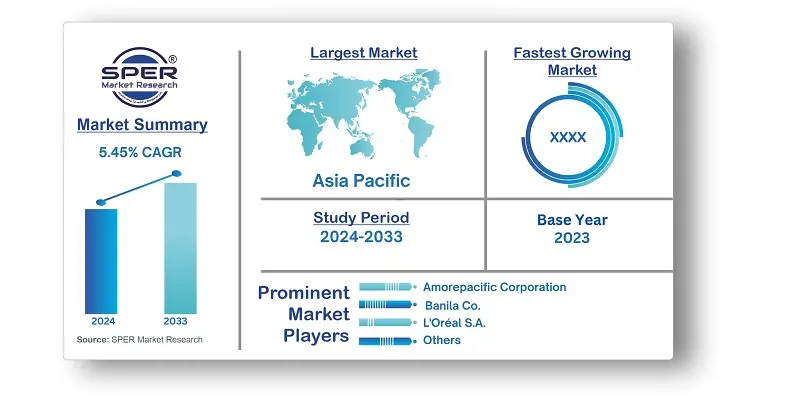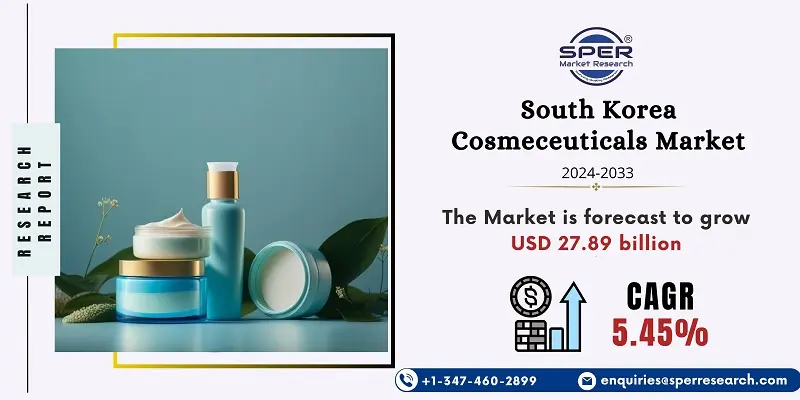
South Korea Cosmeceuticals Market Trends, Share, Size, Revenue, Demand and Future Outlook
South Korea Cosmeceuticals Market Growth, Size, Trends Analysis- By Product Type, By Category, By Distribution Channel- Regional Outlook, Competitive Strategies and Segment Forecast to 2033
| Published: Oct-2024 | Report ID: FMCG24163 | Pages: 1 - 107 | Formats*: |
| Category : Consumer & Retail | |||
- In January 2022, Colorsonic and Copyright, two state-of-the-art advancements in beauty technology, were unveiled by the L'Oréal Group to both clients and stylists. They are both lightweight, portable gadgets with color apps. Consumers may use Colorsonic, but hair salons are granted copyright.
- Amorepacific, a leader in natural luxury skin care, revealed in September 2022 that it has acquired Tata Harper, a premium clean beauty company. Amorepacific plans to use the brand acquisition to grow its product line in the Americas and Europe.


| Report Metric | Details |
| Market size available for years | 2020-2033 |
| Base year considered | 2023 |
| Forecast period | 2024-2033 |
| Segments covered | By Product Type, By Category, By Distribution Channel |
| Regions covered | Eastern Region, Western Region, Northern Region, Southern Region |
| Companies Covered | Amorepacific Corporation, Banila Co., Clubclio Co. Ltd, Dr. Jart+, L'Oréal S.A., Nature Republic, PFD Co. Ltd, SON&PARK, The Face Shop (LG Household & Health Care), Samsung Electronics, Unilever Plc. |
- Skincare Enthusiasts
- Health-Conscious Consumers
- Aging Population
- Acne-Prone Individuals
- Sensitive Skin Users
- Beauty Professionals
- Men’s Grooming Segment
- Millennials and Gen Z
| By Product Type: | |
| By Category: | |
| By Distribution Channel: |
- South Korea Cosmeceuticals Market Size (FY’2024-FY’2033)
- Overview of South Korea Cosmeceuticals Market
- Segmentation of South Korea Cosmeceuticals Market By Product Type (Personal Care Products, Cosmetics/Make-up Products)
- Segmentation of South Korea Cosmeceuticals Market By Category (Premium Products, Mass Products)
- Segmentation of South Korea Cosmeceuticals Market By Distribution Channel (Specialty Stores, Supermarkets/Hypermarkets, Convenience Stores, Pharmacies/Drug Stores, Online Retail Channels, Others)
- Expansion Analysis of South Korea Cosmeceuticals Market
- Problems and Obstacles in South Korea Cosmeceuticals Market
- Competitive Landscape in the South Korea Cosmeceuticals Market
- Impact of COVID-19 and Demonetization on South Korea Cosmeceuticals Market
- Details on Current Investment in South Korea Cosmeceuticals Market
- Competitive Analysis of South Korea Cosmeceuticals Market
- Prominent Players in the South Korea Cosmeceuticals Market
- SWOT Analysis of South Korea Cosmeceuticals Market
- South Korea Cosmeceuticals Market Future Outlook and Projections (FY’2024-FY’2033)
- Recommendations from Analyst
1.1. Scope of the report1.2. Market segment analysis
2.1. Research data source2.1.1. Secondary Data2.1.2. Primary Data2.1.3. SPER’s internal database2.1.4. Premium insight from KOL’s2.2. Market size estimation2.2.1. Top-down and Bottom-up approach2.3. Data triangulation
4.1. Driver, Restraint, Opportunity and Challenges analysis4.1.1. Drivers4.1.2. Restraints4.1.3. Opportunities4.1.4. Challenges4.2. COVID-19 Impacts of the South Korea Cosmeceuticals Market
5.1. SWOT Analysis5.1.1. Strengths5.1.2. Weaknesses5.1.3. Opportunities5.1.4. Threats5.2. PESTEL Analysis5.2.1. Political Landscape5.2.2. Economic Landscape5.2.3. Social Landscape5.2.4. Technological Landscape5.2.5. Environmental Landscape5.2.6. Legal Landscape5.3. PORTER’s Five Forces5.3.1. Bargaining power of suppliers5.3.2. Bargaining power of buyers5.3.3. Threat of Substitute5.3.4. Threat of new entrant5.3.5. Competitive rivalry5.4. Heat Map Analysis
6.1. South Korea Cosmeceuticals Market Manufacturing Base Distribution, Sales Area, Product Type6.2. Mergers & Acquisitions, Partnerships, Product Launch, and Collaboration in South Korea Cosmeceuticals Market
7.1. South Korea Cosmeceuticals Market Size, Share and Forecast, By Product Type, 2020-20267.2. South Korea Cosmeceuticals Market Size, Share and Forecast, By Product Type, 2027-20337.3. Personal Care Products7.3.1. Hair Care7.3.1. Conditioner7.3.1. Shampoo7.3.1. Others7.3.2. Skin Care7.3.2. Facial Care Products7.3.2. Body Care Products7.3.2. Lip Care Products7.3.3. Bath and Shower7.3.3. Shower Gels7.3.3. Soaps7.3.3. Others7.3.4. Oral Care7.3.4. Toothbrush7.3.4. Toothpaste7.3.4. Mouthwashes and Rinses7.3.4. Others7.3.5. Men’s Grooming Products7.3.6. Deodorants and Antiperspirants7.4. Cosmetics/Make-up Products7.4.1. Facial Cosmetics7.4.2. Eye Cosmetics7.4.3. Lip and Nail Make-up Products7.4.4. Hair Styling and Colouring
8.1. South Korea Cosmeceuticals Market Size, Share and Forecast, By Category, 2020-20268.2. South Korea Cosmeceuticals Market Size, Share and Forecast, By Category, 2027-20338.3. Premium Products8.4. Mass Products
9.1. South Korea Cosmeceuticals Market Size, Share and Forecast, By Distribution Channel, 2020-20269.2. South Korea Cosmeceuticals Market Size, Share and Forecast, By Distribution Channel, 2027-20339.3. Specialty Stores9.4. Supermarkets/Hypermarkets9.5. Convenience Stores9.6. Pharmacies/Drug Stores9.7. Online Retail Channels9.8. Others
10.1. South Korea Cosmeceuticals Market Size and Market Share
11.1. South Korea Cosmeceuticals Market Size and Market Share By Region (2020-2026)11.2. South Korea Cosmeceuticals Market Size and Market Share By Region (2027-2033)11.3. Eastern Region11.4. Western Region11.5. Northern Region11.6. Southern Region
12.1. Amorepacific Corporation12.1.1. Company details12.1.2. Financial outlook12.1.3. Product summary12.1.4. Recent developments12.2. Banila Co.12.2.1. Company details12.2.2. Financial outlook12.2.3. Product summary12.2.4. Recent developments12.3. Clubclio.Co.Ltd12.3.1. Company details12.3.2. Financial outlook12.3.3. Product summary12.3.4. Recent developments12.4. Dr. Jart+12.4.1. Company details12.4.2. Financial outlook12.4.3. Product summary12.4.4. Recent developments12.5. L'Oréal S.A.12.5.1. Company details12.5.2. Financial outlook12.5.3. Product summary12.5.4. Recent developments12.6. Nature Republic12.6.1. Company details12.6.2. Financial outlook12.6.3. Product summary12.6.4. Recent developments12.7. PFD Co. Ltd12.7.1. Company details12.7.2. Financial outlook12.7.3. Product summary12.7.4. Recent developments12.8. SON&PARK12.8.1. Company details12.8.2. Financial outlook12.8.3. Product summary12.8.4. Recent developments12.9. The Face Shop (LG Household & Health Care)12.9.1. Company details12.9.2. Financial outlook12.9.3. Product summary12.9.4. Recent developments12.10. Samsung Electronics12.10.1. Company details12.10.2. Financial outlook12.10.3. Product summary12.10.4. Recent developments12.11. Unilever Plc12.11.1. Company details12.11.2. Financial outlook12.11.3. Product summary12.11.4. Recent developments12.12. Others
SPER Market Research’s methodology uses great emphasis on primary research to ensure that the market intelligence insights are up to date, reliable and accurate. Primary interviews are done with players involved in each phase of a supply chain to analyze the market forecasting. The secondary research method is used to help you fully understand how the future markets and the spending patterns look likes.
The report is based on in-depth qualitative and quantitative analysis of the Product Market. The quantitative analysis involves the application of various projection and sampling techniques. The qualitative analysis involves primary interviews, surveys, and vendor briefings. The data gathered as a result of these processes are validated through experts opinion. Our research methodology entails an ideal mixture of primary and secondary initiatives.



Frequently Asked Questions About This Report
PLACE AN ORDER
Year End Discount
Sample Report
Pre-Purchase Inquiry
NEED CUSTOMIZATION?
Request CustomizationCALL OR EMAIL US
100% Secure Payment






Related Reports
Our Global Clients
Our data-driven insights have influenced the strategy of 200+ reputed companies across the globe.






















